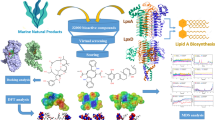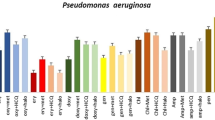Abstract
Antibiotic resistance prevalent in various infectious pathogens towards diverse types of antimicrobials has emerged as a global cause of public health threat. The limitations in knowing the key drug binding sites of receptors in various resistance factors due to inadequacy of experimentally solved 3D structures have left resistance therapeutics research vague. Hence, in this study, we have demonstrated the importance of structure elucidation of aminoglycoside phosphotransferase (APH) enzyme from members of B. cereus sensu lato group by homology modeling technique. We have appropriately built 3D models of APH from volatile human pathogens like B. thuringiensis, B. mycoides, B. pseudomycoides, B. weihenstephanensis, and B. anthracis and validated them for stereochemical qualities. The Z-score analysis and structure superimposition study of template with homology models showed close resemblance of models with template 3TDW. The stereochemically validated model of APH from B. thuringiensis, B. mycoides, B. pseudomycoides, B. weihenstephanensis, and B. anthracis was deposited in the PMDB with identifier numbers as PM0082322, PM0082324, PM0082323, PM0082257, and PM0082321, respectively. The stability of all APH models was confirmed by performing molecular dynamics (MD) simulation for 50 ns. The undistorted behavior of secondary structure elements, i.e., helices and sheets from all APH models, was demonstrated using DSSP plot and found consistent over the entire simulation run. These APH models could be further explored for studying mechanism of resistance at molecular level and could be targeted for drug discovery. Thus, this study gives a comprehensive overview about the importance to structure elucidation for combating antibiotic resistance at the earliest.



Similar content being viewed by others
Data availability
Data in the form of 3D models of APH that support the findings of this study have been deposited in the PMDB (Protein Model DataBase) with PMDB IDs as PM0082322, PM0082324, PM0082323, PM0082257, and PM0082321.
Code availability
Not applicable.
References
Stenfors Arnesen LP, Fagerlund A, Granum PE (2008) From soil to gut: Bacillus cereus and its food poisoning toxins. FEMS Microbiol Rev 32:579–606
Zwick ME, Joseph SJ, Didelot X et al (2012) Genomic characterization of the Bacillus cereus sensulato species: backdrop to the evolution of Bacillus anthracis. Genome Res 22:1512–1524
Bottone EJ (2010) Bacillus cereus, a volatile human pathogen. Clin Microbiol Rev 23:382–398
Jensen GB, Hansen BM, Eilenberg J, Mahillon J (2003) The hidden lifestyles of Bacillus cereus and relatives. Environ Microbiol 5:631–640
Wright GD (2005) Bacterial resistance to antibiotics: enzymatic degradation and modification. Adv Drug Deliv Rev 57:1451–1470
França TCC (2015) Homology modeling: an important tool for drug discovery. J Biomol Struct Dyn 33:1780–1793
Parulekar RS, Sonawane KD (2017) Molecular modeling studies to explore the binding affinity of virtually screened inhibitor toward different aminoglycoside kinases from diverse MDR strains. J Cell Biochem 119:2679–2695
Parulekar RS, Sonawane KD (2018) Insights into the antibiotic resistance and inhibition mechanism of aminoglycoside phosphotransferase from Bacillus cereus: in silico and in vitro perspective. J Cell Biochem 119:9444–9461
Wheeler DL, Barrett T, Benson DA, Bryant SH, Canese K, Chetvernin V, Feolo M (2007) Database resources of the national center for biotechnology information. Nucleic Acids Res 36(suppl_1):D13-D21
Altschul SF, Madden TL, Schäffer AA et al (1997) Gapped BLAST and PSI-BLAST: a new generation of protein database search programs. Nucleic Acids Res 25:3389–3402
Berman HM, Battistuz T, Bhat TN et al (2002) The Protein Data Bank. Acta Crystallogr D Biol Crystallogr 58:899–907
Šali A, Blundell TL (1993) Comparative protein modeling by satisfaction of spatial restraints. J Mol Biol 234:779–815
Xu D, Zhang Y (2011) Improving the physical realism and structural accuracy of protein models by a two-step atomic-level energy minimization. Biophys J 101:2525–2534
Wiederstein M, Sippl MJ (2007) ProSA-web: interactive web service for the recognition of errors in three-dimensional structures of proteins. Nucleic Acids Res 35:407–410
Colovos C, Yeates TO (1993) Verification of protein structures: patterns of nonbonded atomic interactions. Protein Sci 2:1511–1519
Pettersen EF, Goddard TD, Huang CC et al (2004) UCSF Chimera—a visualization system for exploratory research and analysis. J Comput Chem 25:1605–1612
Abraham MJ, Murtola T, Schulz R, Páll S, Smith JC, Hess B, Lindahl E (2015) GROMACS: high performance molecular simulations through multi-level parallelism from laptops to supercomputers. SoftwareX 1:19–25
Kaminski GA, Friesner RA, Tirado-Rives J, Jorgensen WL (2001) Evaluation and reparametrization of the OPLS-AA force field for proteins via comparison with accurate quantum chemical calculations on peptides. J Phys Chem B 105:6474–6487
Hess B, Bekker H, Berendsen HJC, Fraaije JGEM (1997) LINCS: a linear constraint solver for molecular simulations. J ComputChem 18:1463–1472
Essmann U, Perera L, Berkowitz ML, Darden T, Lee H, Pedersen LG (1995) A smooth particle mesh Ewald method. J Chem Phys 103:8577–8593
Smith CA, Toth M, Frase H, Byrnes LJ, Vakulenko SB (2012) Aminoglycoside 2″- phosphotransferase IIIa (APH(2″)-IIIa) prefers GTP over ATP: structural templates for nucleotide recognition in the bacterial aminoglycoside-2″ kinases. J Biol Chem 287:12893–12903
Barale SS, Parulekar RS, Fandilolu PM, Dhanavade MJ, Sonawane KD (2019) Molecular insights into destabilization of Alzheimer’s Aβ protofibril by arginine containing short peptides: a molecular modeling approach. ACS Omega 4:892–903
Dhanavade MJ, Parulekar RS, Kamble SA, Sonawane KD (2016) Molecular modeling approach to explore the role of cathepsin B from Hordeum vulgare in the degradation of Aβ peptides. Mol Biosyst 12:162–168
Dhanavade MJ, Sonawane KD (2014) Insights into the molecular interactions between aminopeptidase and amyloid beta peptide using molecular modeling techniques. Amino Acids 46:1853–1866
Acknowledgements
The authors are very much thankful to Computer Centre, Shivaji University, Kolhapur, for providing the computational facility.
Funding
This study was funded by UGC SAP Phase II (vide letter No. F. 4–8/2015/DRS-II (SAP-II) program sanctioned to Department of Biochemistry. KDS received financial support under UGC SAP Phase II (vide letter No. F. 4–8/2015/DRS-II (SAP-II) programme sanctioned to Department of Biochemistry, Shivaji University, Kolhapur, from University Grants Commission, New Delhi, UGC provided BSR fellowship under UGC SAP DRS Phase I programme (vide letter No.F.7–207/2009 (BSR) to RSP. DST SERB (EMR/2017/002688/BBM) and DST PURSE-II provided financial support to KDS. KDS also received from “DBT-BUILDER Shivaji University Interdisciplinary Life Science Programme for Advance Research and Education (No.: BT/INF/22/SP43063/2022; Date:11–03-2022)” sanctioned by Department of Biotechnology, Ministry of Science & Technology, Government of India.
Author information
Authors and Affiliations
Contributions
Dr.Kailas D. Sonawane contributed to the conceptualization and designing of the study. Dr. Rishikesh S. Parulekar performed material preparation, structural study, data analysis, and drafting of manuscript. All the authors read and approved the final manuscript.
Corresponding author
Ethics declarations
Ethics approval
This article does not contain any studies with human participants or animals performed by any of the authors.
Consent to participate
Not applicable.
Consent for publication
Not applicable.
Competing interests
The authors declare no competing interests.
Additional information
Publisher's Note
Springer Nature remains neutral with regard to jurisdictional claims in published maps and institutional affiliations.
Highlights
• The 3D models of APH from members of B. cereus sensu lato group were built and deposited in PMDB.
• MD simulations for 50 ns confirmed the structural stability of all APH models.
• The DSSP plot revealed the conformational changes of APH models during MD simulation to explore the structural stability.
Supplementary Information
Below is the link to the electronic supplementary material.
Rights and permissions
Springer Nature or its licensor holds exclusive rights to this article under a publishing agreement with the author(s) or other rightsholder(s); author self-archiving of the accepted manuscript version of this article is solely governed by the terms of such publishing agreement and applicable law.
About this article
Cite this article
Parulekar, R.S., Sonawane, K.D. Structure elucidation study of aminoglycoside phosphotransferase from B. cereus sensu lato: a comprehensive outlook for drug discovery. Struct Chem 34, 859–865 (2023). https://doi.org/10.1007/s11224-022-02040-9
Received:
Accepted:
Published:
Issue Date:
DOI: https://doi.org/10.1007/s11224-022-02040-9




